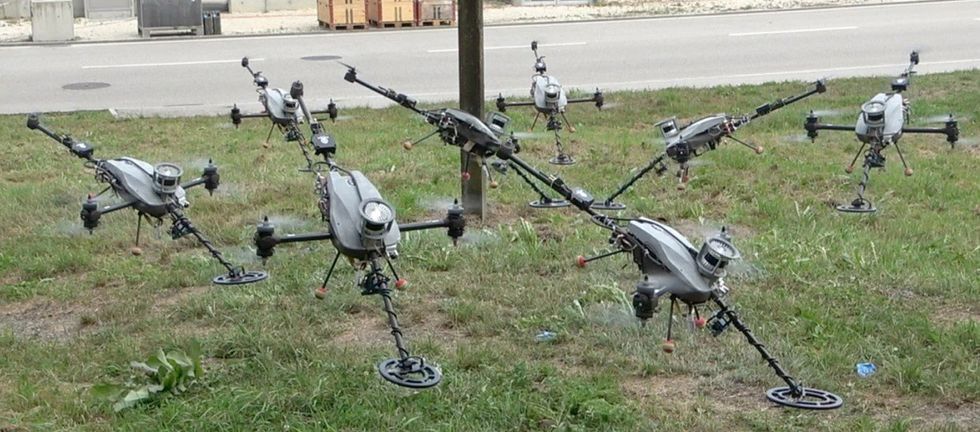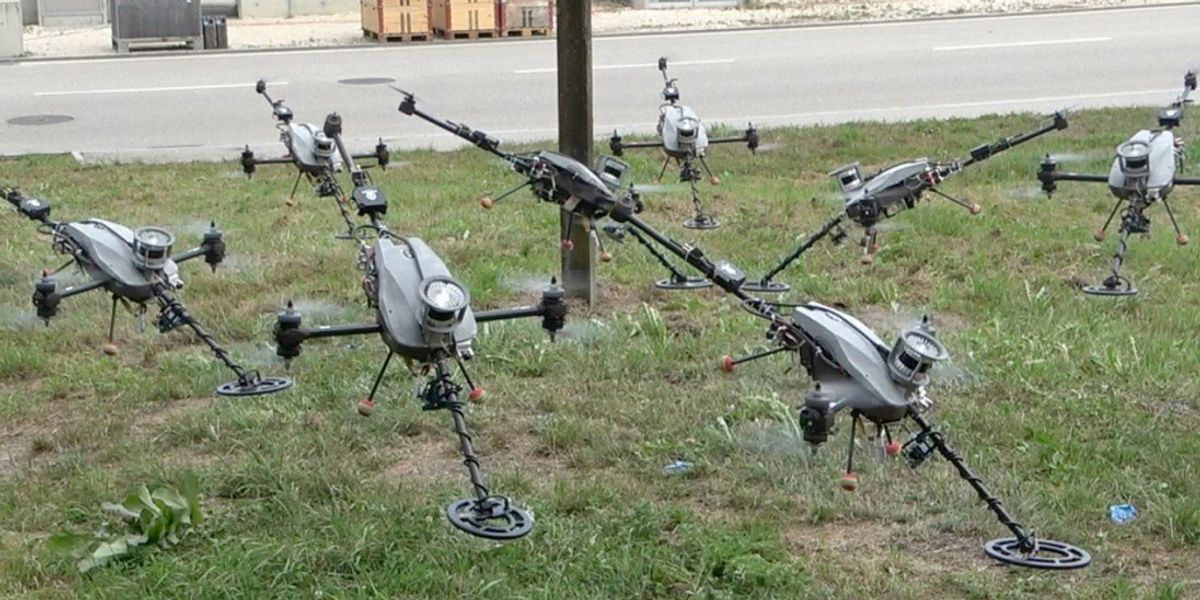
Steel detecting could be a enjoyable pastime, or it may be a activity to be accomplished in lethal earnest—if the buried treasure you’re looking for consists of landmines and explosive remnants of battle. This is a gigantic, harmful drawback: One thing like 12,000 sq. kilometers worldwide are basically ineffective and uninhabitable due to the specter of buried explosives, and 1000’s and 1000’s of individuals are injured or killed yearly.
Whereas there are numerous alternative ways of detecting mines and explosives, none of them are notably fast or straightforward. For apparent causes, sending a human out right into a minefield with a steel detector shouldn’t be the most secure manner of doing issues. So, as a substitute, individuals ship the rest that they presumably can, from machines that may smash by minefields with brute pressure to well-trained rats that take a extra passive strategy by sniffing out explosive chemical compounds.
As a result of the vast majority of mines are triggered by stress or direct proximity, a drone looks as if it will be the perfect manner of detecting them non-explosively. Nevertheless, until you’re solely detecting over a superbly flat floor (and maybe not even then) your detector gained’t be positioned ideally more often than not, and also you may miss one thing, which isn’t a viable possibility for mine detection.
However now a novel mixture of a steel detector and a drone with 5 levels of freedom is below improvement on the Autonomous Programs Lab at ETH Zurich. It could present a viable answer to distant landmine detection, through the use of cautious sensing and localization together with some twisting motors to maintain the detector reliably near the bottom.
The actually difficult a part of this entire factor is ensuring that the steel detector stays on the right orientation relative to the bottom floor so there’s no dip in its effectiveness. With a standard drone, this wouldn’t work in any respect, as a result of each time the drone strikes in any course however up or down, it has to tilt, which goes to additionally tilt something that’s connected to it. Except you need to mount your steel detector on some type of (possible difficult and heavy) gimbal system, you want a drone that may translate its place with out tilting, and fortunately, such a drone not solely exists however is commercially obtainable.
The drone used on this analysis is made by an organization known as Voliro, and it’s a tricopter that makes use of rotating thruster nacelles that transfer independently of the physique of the drone. It could not shock you to study that Voliro (which has, up to now, made some actually bizarre flying robots) is a startup with its roots within the Autonomous Programs Lab at ETH Zurich, the identical place the place the mine-detecting drone analysis is happening.
So, now that you’ve a drone that theoretically able to making your steel detector work, you must design the management system that makes it work in follow. The system wants to have the ability to pilot the drone throughout a 3D floor it has by no means seen earlier than and which could embody obstacles. In the meantime, it should prioritize the alignment of the detector. The researchers mix GPS with inertial measurements from a lidar mounted on the drone for absolute place and state estimation, after which autonomously plots and executes a “boustrophedon protection path” throughout an space of curiosity. “Boustrophedon,” which isn’t a phrase that I knew existed till simply this minute, refers to one thing (normally writing) wherein alternate traces are reversed (and mirrored). So, proper to left, after which left to proper.
Testing with metallic (non-explosive) targets confirmed that this method does very effectively, even in areas with obstacles, overhead occlusion, and vital slope. Whether or not it’s finally field-useful or not would require some additional investigation, however as a result of the platform itself is industrial off-the-shelf {hardware}, there’s a bit extra room for optimism than there in any other case could be.
A analysis paper, “Resilient Terrain Navigation with a 5 DOF Steel Detector Drone” by Patrick Pfreundschuh, Rik Bähnemann, Tim Kazik, Thomas Mantel, Roland Siegwart, and Olov Andersson from the Autonomous Programs Lab at ETH Zurich, might be introduced in Could at ICRA 2023 in London.
From Your Website Articles
Associated Articles Across the Net


You’re so awesome! I don’t believe I have read a single thing like that before. So great to find someone with some original thoughts on this topic.
You’re so awesome! I don’t believe I have read a single thing like that before. So great to find someone with some original thoughts on this topic.
I am truly thankful to the owner of this web site who has shared this fantastic piece of writing at at this place. Watch bbc persian lıve
very informative articles or reviews at this time.
I like the efforts you have put in this regards for all the great content.
Good post! We will be linking to this particularly great post on our site. Keep up the great writing
We always follow your beautiful content I look forward to the continuation.<a href="https://www.toolbarqueries.google.iq/url?sa=t
This post post made me think. will write something about this on my blog. ave a nice day!! .-vox tv live stream
it’s awesome article. look forward to the continuation.Clean Touch Ink Pad for Baby Handprints and Footprints – Inkless Infant Hand
atorvastatin 40mg price lipitor 10mg generic buy lipitor 40mg pill
Some really excellent info I look forward to the continuation. – hey dudes mens
order propecia cost proscar 1mg diflucan cost
cipro online – myambutol price buy augmentin 375mg online cheap
ciprofloxacin cost – buy amoxiclav sale cheap clavulanate
order metronidazole 200mg online cheap – cefaclor 500mg uk zithromax us
ciplox 500 mg ca – cheap chloromycetin online order erythromycin 250mg online
how to buy valacyclovir – order mebendazole online cheap buy zovirax online cheap
buy ivermectin 12 mg online – ceftin over the counter buy tetracycline 250mg for sale
flagyl 400mg us – cheap amoxil pills where to buy azithromycin without a prescription
ampicillin generic buy acillin tablets cheap amoxil
lasix 40mg over the counter – coumadin 2mg price brand captopril
brand metformin 500mg – order bactrim 960mg online cheap order lincomycin 500 mg without prescription
oral zidovudine 300mg – avalide order online allopurinol 100mg price
clozaril 100mg usa – ramipril for sale online famotidine 20mg usa
generic quetiapine 100mg – buy luvox pills eskalith pills
order clomipramine online – buy anafranil 50mg generic brand doxepin
hydroxyzine online – buy buspar 5mg for sale buy endep 10mg generic
order amoxiclav generic – myambutol online buy ciprofloxacin 1000mg pills
order cleocin 300mg for sale – suprax 200mg ca cheap chloromycetin generic
azithromycin 250mg brand – buy ciprofloxacin 500mg without prescription brand ciprofloxacin 500 mg
albuterol 2mg usa – theo-24 Cr for sale theo-24 Cr drug
ivermectin medicine – buy generic aczone buy cefaclor 500mg online cheap
It’s nice to see the best quality content from such sites.
order clarinex 5mg for sale – buy clarinex 5mg online cheap best antihistamine for runny nose
purchase medrol pills – buy fml-forte sale brand azelastine 10 ml
buy glyburide online cheap – forxiga 10 mg cheap order dapagliflozin 10 mg online
order repaglinide 1mg without prescription – empagliflozin 25mg canada buy empagliflozin pills for sale
glycomet 1000mg brand – buy sitagliptin 100 mg online acarbose usa
lamisil brand – buy generic diflucan 100mg order griseofulvin sale
buy famvir 250mg for sale – cost zovirax 800mg cost valcivir 500mg
order lanoxin 250mg generic – lasix 100mg without prescription furosemide order
cheap nitroglycerin – purchase clonidine pill diovan ca